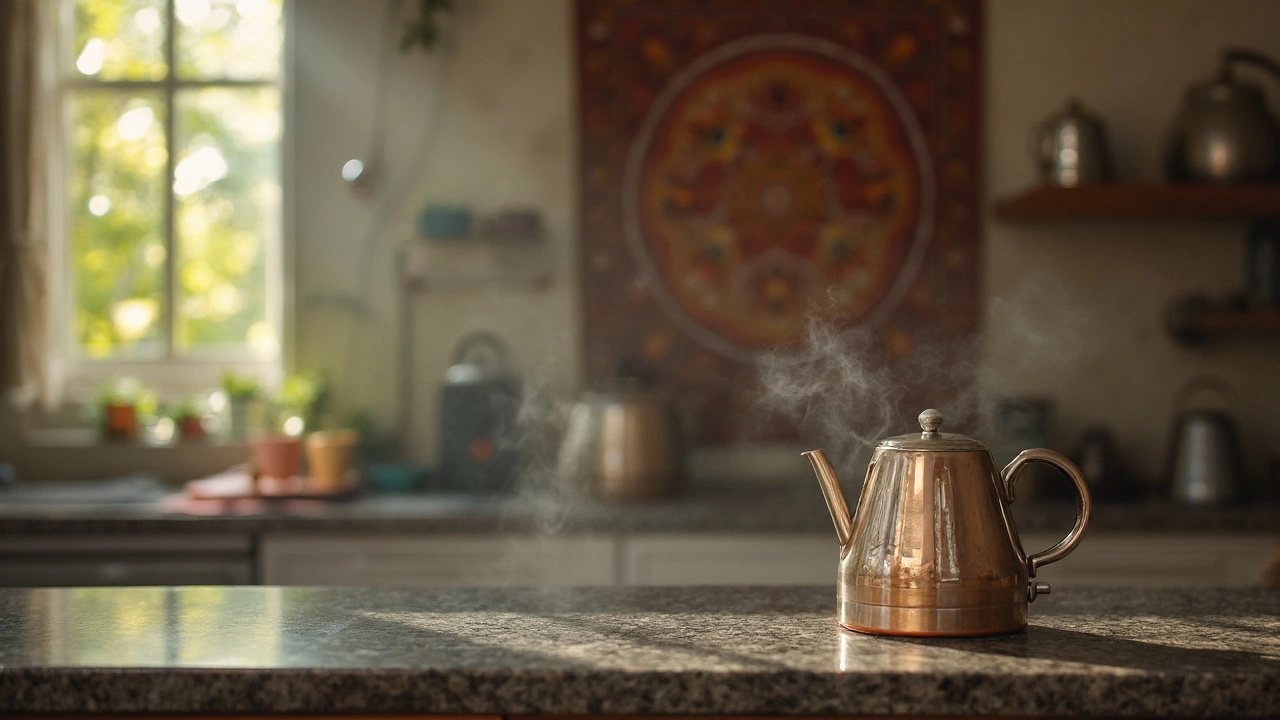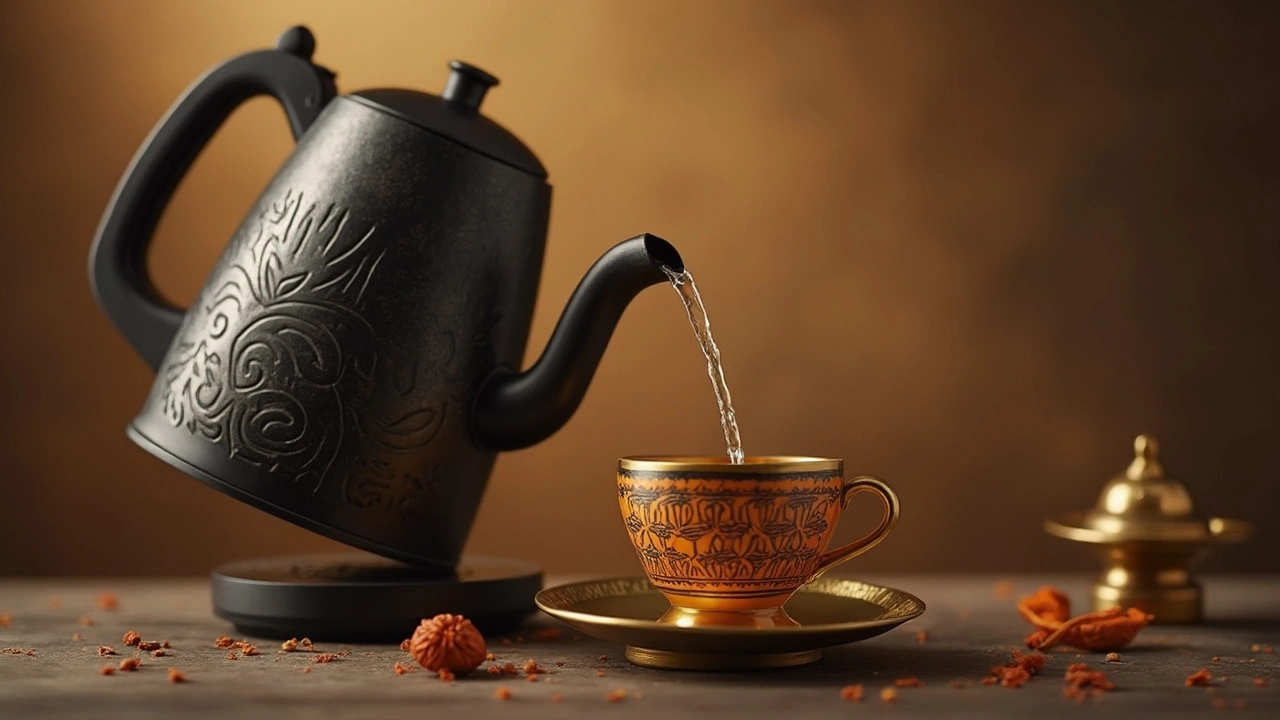
Ever wondered if boiling water in your electric kettle is as safe as it seems? It might seem like a no-brainer, yet it comes with its nuances. Using electric kettles is super convenient for that quick cup of tea or coffee. But, can this appliance affect the quality of our water and ultimately our health? That's what we're diving into today.
First things first—electric kettles have become kitchen staples because of their efficiency. But not all kettles are made equally, and the material they're made from can influence the water. For example, plastic kettles might release harmful chemicals when heated. Yeah, not the best thing to sip with your morning brew.
So, how do you know which kettle is right for you, and what steps can you take to ensure your water stays healthy? Stick around; we're about to spill some crucial tips that might change how you think about your trusty kettle.
- Understanding Electric Kettles
- Potential Risks from Electric Kettles
- Benefits of Using Electric Kettles
- Materials and Their Impact
- How to Choose a Safe Kettle
- Maintenance Tips for Optimal Safety
Understanding Electric Kettles
Electric kettles have surely made boiling water a breeze. Just plug them in, press a button, and in a couple of minutes, voilà! Hot water ready to go. But what are these trusty appliances all about?
An electric kettle works by converting electrical energy into heat to raise the temperature of water. This means convenience, especially on those chilly mornings when you just need a hot mug in your hands stat.
Key Features of Electric Kettles
Most electric kettles are equipped with features such as automatic shut-off, so no worries about leaving it unattended. Some even have temperature controls for precise brewing, which is a plus if you're a bit of a coffee or tea connoisseur.
- Material Matters: They come in various materials like stainless steel, glass, and plastic. Each material has its pros and cons regarding weight, durability, and potential chemical release.
- Energy Efficiency: By boiling water faster and using electricity directly, they can be more energy efficient compared to stove-top kettles.
Types of Electric Kettles
The variety is wide, from basic models to high-tech smart kettles you can control with your smartphone. There's something for everyone, whether you need a simple setup or a gadget that's high on tech.
Fun fact: Studies have shown that in 2022, about 80% of households owned an electric kettle! Clearly, these devices aren't going out of style anytime soon.
Next time you fill up your kettle, take a moment to appreciate the tech doing all the heavy lifting in giving you that perfect cup of warmth. It's not just a kitchen appliance; it's your ally in making life a little easier.
Potential Risks from Electric Kettles
So, let's get into the nitty-gritty of potential risks posed by electric kettles. You might not think about it while waiting for your water to boil, but certain risks are lurking there.
Release of Harmful Chemicals
One concern revolves around the materials used in electric kettles. Many kettles are made of plastic, which, when heated, might release chemicals like BPA into the water. These chemicals can interfere with the body’s hormonal system, so it’s better to err on the side of caution and check labels to ensure materials are BPA-free.Leaching of Metals
Another risk involves metal kettles. Sometimes, elements like nickel, lead, or even cadmium can leach into the water, especially if you have an older or lower-quality kettle. It's important to choose stainless steel options with high safety ratings to minimize this risk.Boiling Dry and Electrical Hazards
There's a technical risk: boiling the kettle dry. This can damage the heating element or cause a short circuit. Always ensure there's enough water in the kettle before flipping that switch.If you're already lifting your eyebrows, this might drive it home further:
| Material | Potential Risk |
|---|---|
| Plastic | Release of BPA or other chemicals |
| Metal | Leaching of nickel, lead, or cadmium |
These tables break down what reactions to watch out for with your electric kettle.
You don't have to ditch your kettle, though! Being aware and choosing kettles from trusted brands with certification can greatly minimize these risks.
Benefits of Using Electric Kettles
Electric kettles have made life so much easier, haven't they? These little gadgets might seem simple, but they've got some serious perks that you shouldn't overlook.
Speedy Heating
One of the biggest reasons people love electric kettles is their incredible speed. Unlike stove-top kettles or microwaves, electric ones are designed to boil water in mere minutes. This speed not only saves you time but also consumes less energy, making it a win-win for you and your utility bill.
Energy Efficiency
Electric kettles are known for being more energy-efficient than traditional methods. The heat is directed specifically to the water instead of escaping into the surrounding air. Now, who doesn't want to save a bit of money while being environmentally friendly?
Temperature Control
Many advanced models come with temperature control settings. This is super handy if you're a tea lover, as different types of tea require different water temperatures to bring out their best flavors. No more guesswork—just perfectly brewed tea every time.
Safety Features
Modern electric kettles include safety features like automatic shut-off and boil-dry protection. That means you don't have to hover around waiting for the water to boil, worried about forgetting and causing a mishap.
Convenience and Portability
Last but not least, the convenience factor is massive. Just plug them in, fill them up, and you're good to go—even if you're on the move. They're lightweight and portable, making them perfect for travel, office use, or even moving between rooms.
With all these benefits, it's easy to see why electric kettles have become an essential part of daily routines across the globe. So next time you hit that switch, take a second to appreciate just how much easier these clever devices make our lives!
| Feature | Benefit |
|---|---|
| Speed | Boils water in minutes |
| Energy Efficiency | Less energy consumption than stove-top |
| Temperature Control | Perfect brewing for different teas |
| Safety Features | Automatic shut-off, boil-dry protection |

Materials and Their Impact
When it comes to electric kettles, the material they’re made from is a big deal. Why? Because it can affect the water you drink. Let's break down the common materials used and what you should be aware of.
Plastic Kettles
Plastic kettles are lightweight and often cheaper, making them a popular choice. However, when plastics are heated, they can release chemicals like BPA, which isn't great for your health. Some manufacturers offer BPA-free options, but it's something to double-check before buying.
Stainless Steel Kettles
Stainless steel kettles are known for their durability and safety. They don’t contain harmful chemicals, making them a safer choice compared to plastic. They're also quite efficient at retaining heat, so your water stays hotter for longer. Bonus!
Glass Kettles
Glass kettles look stylish and have the added benefit of being able to see the water boiling. They're considered safe because they don't release chemicals into the water. Just be cautious with their fragility; glass can break if dropped.
Ceramic Kettles
Ceramic is another safe option. These kettles usually come in beautiful designs and keep the water tasting pure. They tend to be a bit heavier but are excellent at retaining heat.
| Material Type | Pros | Cons |
|---|---|---|
| Plastic | Lightweight, affordable | Potential chemical leaching |
| Stainless Steel | Durable, safe | Can be more expensive |
| Glass | Chemically safe, aesthetic | Fragile |
| Ceramic | Retains heat well, safe | Heavy |
So, what's the takeaway? If you're worried about water safety from your electric kettle, consider stainless steel or glass options. They offer a good balance of safety and functionality. Keep in mind, spending a little more on a quality kettle can save you from health concerns down the road.
How to Choose a Safe Kettle
Picking the right electric kettle goes beyond just picking one that looks good on your counter. You want a reliable one that keeps you healthy. So, what should you be on the lookout for when shopping for a new kettle?
Material Matters
The material your kettle is made of can make a world of difference. Stainless steel and glass kettles are your safest bets. Plastic kettles, while cheaper, might leach chemicals when heated. That’s hardly appetizing in your morning tea, right?
Temperature Controls
Some kettles have adjustable temperature settings. This is perfect if you're a tea enthusiast, as different types of tea benefit from different brewing temperatures. Plus, lower temperatures use less energy, making them a more eco-friendly choice.
Safety Features
Look for kettles with auto shut-off or boil-dry protection. Forgetting you put the kettle on happens, and these features can prevent potential hazards. It's like having a little guardian angel watching over your appliance.
Size and Volume
Consider how much water you'll typically need to boil. If you often find yourself boiling water for a family, a larger kettle will save you time. But if it's just afternoon tea for one, a smaller capacity might be more energy-efficient.
- Consider glass or stainless steel over plastic for safer materials.
- Look for models with temperature settings for versatility and energy savings.
- Ensure safety features like auto shut-off are included.
- Match the kettle size to your typical use to maximize efficiency.
These tips should point you to a safe electric kettle that meets your needs while keeping your water just the way you want it—healthy.
Maintenance Tips for Optimal Safety
Taking care of your electric kettle is no rocket science, but it sure makes a huge difference in both safety and durability. Let's kick things off with some practical ways to keep your kettle in top-notch condition.
Descaling the Kettle
One of the first things you should do is descale your kettle regularly. Minerals build up when you boil water and can affect both the taste and safety of your brew. A simple vinegar or lemon solution does the trick:
- Fill the kettle halfway with a mixture of one part water and one part vinegar or lemon juice.
- Let it sit for about an hour.
- Boil the solution and then rinse the kettle thoroughly.
It's kind of like giving your kettle a mini spa day!
Inspect for Damages Regularly
So here's the deal: always check your kettle for any signs of damage. Cracks or faulty buttons aren’t just cosmetic issues—they can be safety hazards. Replace damaged parts pronto to keep your electric kettle safe and sound.
Keep the Filter and Spout Clean
The filter and spout are often overlooked but super crucial for clean water. A simple rinse and gentle scrub with a brush every week keeps them in perfect shape.
Avoid Overfilling and Dry Boiling
It's tempting to fill your kettle to the brim when you're in a hurry, but don't. Overfilling can lead to water spillage and potential electrical issues. And always make sure there's water in the kettle before turning it on to avoid dry boiling—it can damage the heating element.
Use Quality Water
If you want to keep your kettle running smoothly, consider using filtered or bottled water. Hard water can accelerate mineral build-up, which means more frequent cleaning.
Following these tips not only prolongs the life of your kettle but also ensures the everyday safety and healthiness of your water. Happy boiling!